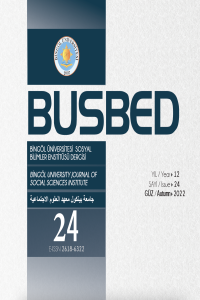Abstract
On dokuzuncu yüzyıl Britanya’sında, kadınların doğal yeri kendilerini ev işlerine ve aile hayatına adayabilecekleri tek yer olan ev olarak görülmekteydi. Ancak bazı siyasi, ekonomik ve sosyal değişimler sayesinde, kadınlar daha önce sadece erkeklere mahsus olan bazı alanlara da ilgi duymaya başladı. Viktorya döneminde yaşayan bazı kadınlar için yazarlık bu alanlardan biriydi. Her ne kadar erkek takma adlarını kullansalar da Mary Ann Evans gibi bazı kadın yazarlar bu dönemde önemli eserler kaleme aldı. Bu eserlerin pek çoğunda ise, kadın yazarlar Viktorya toplumunda kadınlara biçilen rolü sorgulamıştır. Farklı edebi stratejiler kullanarak, Viktorya romanında sıklıkla karşılaşılan geleneksel kadın temsillerine karşı çıkmışlarıdır. Bu bağlamda, bu çalışma George Eliot ve Elizabeth Gaskell gibi iki önemli kadın yazarın en çok bilinen eserlerini inceleyerek, söz konusu yazarların başarısız evlilikleri ve evde kalmışlık durumunu nasıl birer sembolik feminist kavram olarak kullandıklarını göstermeyi amaçlamaktadır. Çalışmanın sonuçları, Eliot ve Gaskell’in istenmeyen evliliklerin yıkıcı sonuçlarını ve evde kalmışlık durumunun getirdiği gerçekdışı mutluluk evreni gibi temaları kullanarak, Viktorya dönemi İngiliz toplumunda hâkim olan erkek egemen güce karşı nasıl bir feminist tutum takındıklarını göstermektedir.
References
- Austen, J. (2006). Pride and Prejudice. Cambridge: Cambridge University Press.
- Berend, Z. (2000). "The Best or None!" Spinsterhood in Nineteenth-Century New England. Journal of Social History, 33(4), 935-957.
- Chambers-Schiller, L. V. (1987). Liberty a Better Husband: Single Women in America: The Generations of 1780-1840. Yale: Yale University Press.
- Eagleton, T. (1978). Criticism and Ideology: A Study in Marxist Literary Theory. London: Verso.
- Eger, E. (2010). Bluestockings: Women of Reason from Enlightenment to Romanticism. Basingstoke: Palgrave Macmillan.
- Elliot, G. (1994). Middlemarch. New York: Penguin Books.
- Fryckstedt, M. C. (1987). Defining the Domestic Genre: English Women Novelists of the 1850s. Tulsa Studies in Women’s Literature, 6(1), 9-25.
- Gaskell, E. C. (1966). Cranford. London: University of London Press.
- Hosker, L. (2013). The Spinster in the Works of Neera and Matilde Serao: Other or Mother? In Women and Gender in Post-Unification Italy (p. 50-71). Oxford: Peter Lang. Mill, J. S. (1991). On Liberty and Other Essays. Oxford: Oxford University Press.
- Poovey, M. (1984). The Proper Lady and the Woman Writer: Ideology as Style in the Works of Mary Wollstonecraft, Mary Shelley, and Jane Austen. Chicago: University of Chicago Pres.
Abstract
In nineteenth-century Britain, a woman’s place was regarded to be in the domestic area, devoted to housework and family life. However, thanks to certain political, economic and social changes, women progressively began to engage in pursuits that were previously exclusive to the men. Writing a novel was one of these pursuits for some women in the Victorian era. Although under the pseudonym of a man, women writers like Mary Ann Evans published significant works during this era. In many of their works, these women writers challenged the role that women were supposed to take in Victorian society. Using various literary strategies, they opposed to conventional representations of the woman in Victorian novel. In this context, the present study examines two canonical works by George Eliot and Elizabeth Gaskell to illustrate how these women writers portray marriage and spinsterhood as symbolic feminist concepts. The findings of the study suggest that by illustrating devastating results of undesired marriages and offering a utopian world of happiness for spinsters, Eliot and Gaskell, respectively, take up feminist stances against oppressing power of patriarchal society in England in the Victorian era.
References
- Austen, J. (2006). Pride and Prejudice. Cambridge: Cambridge University Press.
- Berend, Z. (2000). "The Best or None!" Spinsterhood in Nineteenth-Century New England. Journal of Social History, 33(4), 935-957.
- Chambers-Schiller, L. V. (1987). Liberty a Better Husband: Single Women in America: The Generations of 1780-1840. Yale: Yale University Press.
- Eagleton, T. (1978). Criticism and Ideology: A Study in Marxist Literary Theory. London: Verso.
- Eger, E. (2010). Bluestockings: Women of Reason from Enlightenment to Romanticism. Basingstoke: Palgrave Macmillan.
- Elliot, G. (1994). Middlemarch. New York: Penguin Books.
- Fryckstedt, M. C. (1987). Defining the Domestic Genre: English Women Novelists of the 1850s. Tulsa Studies in Women’s Literature, 6(1), 9-25.
- Gaskell, E. C. (1966). Cranford. London: University of London Press.
- Hosker, L. (2013). The Spinster in the Works of Neera and Matilde Serao: Other or Mother? In Women and Gender in Post-Unification Italy (p. 50-71). Oxford: Peter Lang. Mill, J. S. (1991). On Liberty and Other Essays. Oxford: Oxford University Press.
- Poovey, M. (1984). The Proper Lady and the Woman Writer: Ideology as Style in the Works of Mary Wollstonecraft, Mary Shelley, and Jane Austen. Chicago: University of Chicago Pres.
Details
| Primary Language | English |
|---|---|
| Subjects | Creative Arts and Writing |
| Journal Section | Articles |
| Authors | |
| Publication Date | October 30, 2022 |
| Published in Issue | Year 2022Issue: 24 |



